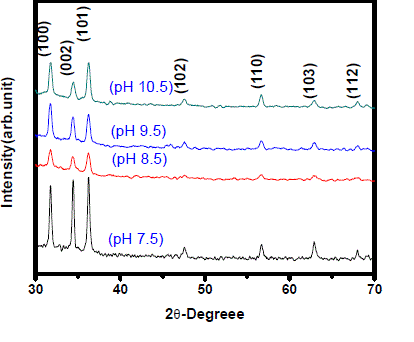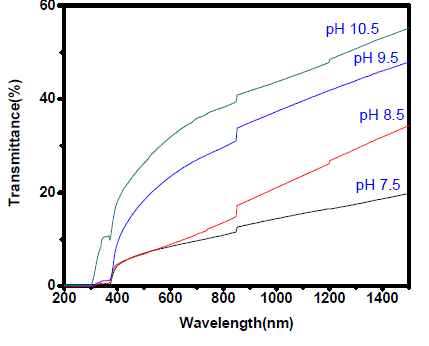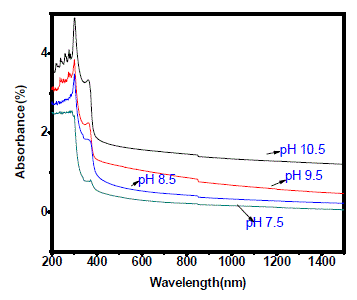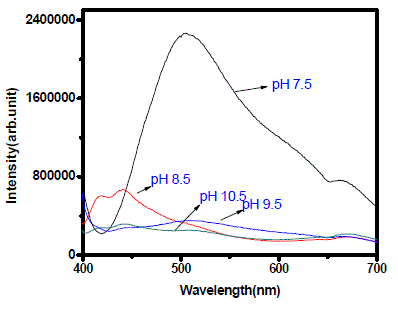ISSN ONLINE(2319-8753)PRINT(2347-6710)
ISSN ONLINE(2319-8753)PRINT(2347-6710)
S.Shankar1, M.Saroja 2,M.Venkatachalam 2, N.Muthukumarasamy 3, V.Kumar 1,4
|
| Related article at Pubmed, Scholar Google |
Visit for more related articles at International Journal of Innovative Research in Science, Engineering and Technology
Multi layer Zinc Oxide thin films with different pH were prepared by sol-gel spin coating technique. Zinc acetate dihydrate (Zn (CH3COO)2 .2H2O), monoethanolamine (MEA,H2N(CH2CH2OH) and isopropanol (CH3C2H5OH, Merck) were used to prepare the coating solution and its pH was varied by adding ammonia and was spin coated on glass substrates at 2000 rpm for 30s. After each deposition the films were pre-heated at 200°C for 10 minutes. The coating was repeated for five times. Finally the films were post heated at 450oC in air atmosphere for 60 minutes. Thickness of the films was found by surface stylus profilometer. The structural properties were investigated by using X-ray diffraction technique and grain size was calculated. The optical properties were investigated using UV-Vis spectroscopy and PL studies and the optical band gap was calculated. The influence of pH on the structural and optical properties of ZnO thin films was reported.
Keywords |
| ZnO thin films, sol-gel, spin coating , pH, structural and optical properties. |
INTRODUCTION |
| Zinc oxide (ZnO) is a II-VI compound semiconductor material with a direct wide band gap of 3.36eV [1] and exciton binding energy of 60 meV [2] at room temperature. It has crystalline structure of the wurtzite type and with lattice constants a = 3.24 Ãâ¡Ãº, c = 5.19 Ãâ¡Ãº [3]. It is one of the most promising materials for the next generation optoelectronic device in the UV region. It has potential use in photo detectors [4], solar cells [5], light emitting diodes (LEDs) [6] , gas sensors [7], surface acoustic devices [8], transparent electrodes [9] and photocatalyst [10][11]. ZnO films have been prepared by various methods of film depositions, which include r.f sputtering [12], pulsed laser deposition [13], laser molecular beam epitaxy [14], electron beam evaporation [15], spray pyrolysis [16], sol-gel process [17]-[20], etc. The sol gel process has distinct advantages over the other techniques due to excellent compositional control, homogeneity on the molecular level due to the mixing of liquid precursors, and lower crystallization temperature [21]. The properties of zinc oxide strongly dependent on the synthesis method and growth parameters such as concentration of the solution, reagents stoichiometry, temperature and pH. Herein, we present a simple sol-gel spin coating route to synthesize the zinc oxide thin films using zinc acetate dihydrate and isopropanol as the precursors. Concentration of zinc acetate and the annealing temperature were standardized as 0.5mol/l and 450oC respectively and the solution pH was varied from 7.5 to 10.5.The influence of pH values of the sol solution on the structural and optical properties of ZnO thin films was investigated. From the investigations, we report that the prepared ZnO thin films can be used for photocatalytic applications. |
II. EXPERIMENT |
| Zinc acetate dihydrate (Zn(CH3COO)2.2H2O), monoethanolamine (MEA,H2N(CH2CH2OH), isopropanol ((CH3 )2CHOH, Merck) were used to prepare the coating solution. All chemicals were of analytical grade and were used without further purification. The molar ratio of MEA to zinc acetate dihydrate was maintained at 1.0 and the concentration of zinc acetate dihydrate was 0.5 mol/l. Zinc acetate dihydrate was used as a starting material. Isoproponol and monoethanolamine were used as the solvent and stabilizer respectively. Zinc acetate dihydrate was first dissolved in isopropanol, then MEA was added drop by drop in the solution. The resultant solution was stirred at 500C for 2h to yield a clear and homogeneous solution and finally the solution was aged at room temperature for 24h. The pH value of the solution was observed as 7.5 was adjusted to the desired value (from 7.5 to 8.5, 9.5, 10.5) by adding ammonia solution drop by drop. The prepared solution was dropped on the cleaned glass substrates and the substrates were rotated at 2000 rpm for 20s (Apex Instruments Co SCU -2008C) and the ZnO thin films were prepared by repeated coating. After each coating the films were heated at 200oC for 10 min to evaporate the solvent and the organic residuals (named as pre-heat treatment) and were allowed to cool to room temperature before applying a new coating. The spin-coating and pre-heating process were repeated for ten times. For crystallization, the ZnO thin films were annealed in a furnace in air atmosphere at 450oC for 60 minutes and allowed to cool to room temperature gradually. The annealing is to convert the organic coating containing Zn2+ into its respective oxide [22]. The thickness of the films was measured using a surface profiler(Alpha-step, TENCOR,USA). The crystallinity of each ZnO film was determined by X-ray diffraction using an (XPERT-PRO) X-ray diffractometer with CuKα radiation source in the range of 20-70o with 0.050 step size. The optical properties were studied by using a UV-Visible spectrophotometer (JASCO Corp., V-570). Photoluminescence spectra have been recorded using a HORIBA JOBINYVON- Fluorolg at an excitation wavelength of 350nm. |
III. RESULTS AND DISCUSSION |
| Fig.1 shows the X-ray diffraction pattern of ZnO thin films as a function of increasing pH from 7.5 to 10.5. |
 |
| Fig.1. X-ray diffraction patterns of ZnO thin films synthesized at different pH values. |
| The detected (hkl) peaks were at 2θ values of 31.70 ,34.40 , 36.20 , 47.50 , 56.60 , 62.80 , and 67.90 corresponding to the lattice planes (100), (002) ,(101) ,(102), (110), (103) and (112) respectively. The data are in good agreement with the standard JCPDS card (36-1451) for hexagonal wurtzite ZnO [22].The intensity of the diffraction peaks is decreasing with the increasing pH of the precursor solution. No characteristic peaks corresponding to impurities are detected which clearly suggests the formation of single phase pure ZnO. The grain size of the ZnO thin films has been estimated from FWHM of (002) diffraction peak using the Scherrer formula [23] d = kλ / βcos θ Where λ is the X-ray wavelength of 1.54Ãâ¡Ãº, θ is the Bragg diffraction angle in degrees, k is a fixed number of 0.9 and β is the FWHM of (002) plane. The grain size was found to be 41.37 nm, 48.27 nm, 48.27 nm and 33.44 nm for the films with pH values of 7.5, 8.5, 9.5 and 10.5 respectively. The thickness of the films was found to decrease from 2.26 to 1.91, 1.41 and 1.03 μm as the solution pH increases. |
| Fig.2 shows the transmittance spectra of ZnO thin film for different pH values. The transmittance of the film prepared |
 |
| Fig .2. UV-Vis transmittance spectra of the ZnO thin films at different pH values. |
| at pH 10.5 was observed to be the highest ~ 55%. The optical transmittance of the film is observed to increase from 15%, 30%, 50% to 55% with increasing pH value. The increase in transmittance may be attributed to the decrease in thickness of the films with increasing pH value. The UV transparencies of all the films were much lower due to electron transitions between the valence band and conduction bands. The substantial decrease in UV transparency must be caused by the scattering from pores and other defects heavily present in the films [24]. Fig .3 shows the optical absorption spectra of ZnO thin films for different pH values of 7.5, 8.5, 9.5 and 10.5. |
 |
| Fig .3. UV-Vis absorption spectra of the ZnO thin films at different pH values. |
| The absorbance spectra of ZnO thin film exhibit a well defined absorbance peak at 300 nm. The absorption below 400 nm is assigned to the intrinsic band gap absorption of ZnO, due to electron transition from the valance band to conduction band. It can be seen that the intensity of the UV peaks decreases with increase of pH value and sharp peaks with maximum intensity in UV region is observed for the film prepared at pH 7.5. The absorption edge shifts to lower wavelength with increase in pH value. The optical band gap energy of ZnO thin films prepared at different pH of 7.5, 8.5, 9.5 and 10.5 was found to be 3.197, 3.127, 3.160 and 3.193eV respectively. As photoluminescence (PL) properties of ZnO are very sensitive to oxygen vacancies, we measured the PL spectra of ZnO thin films. Fig .4 shows room temperature PL spectra for ZnO thin films obtained with an excitation wavelength of 390 nm. It can be seen from fig. 4 ,that the film prepared at pH 7.5 exhibits broad and strong visible emission, the sample prepared at pH 8.5 shows only a strong violet emission. The violet emission is called excitonic emission [25][26], which is closely related to the exciton transition from the localized level below the conduction band to valance band. |
 |
| Fig 4 Photoluminescence spectra of ZnO thin film synthesized at different pH values. |
| The shift of the excitonic emission may be attributed to change of the localized level below the conduction band and the carrier concentration above the valance band in the band gab [25][27].The broad emission band revealed in the visible region is due to the superposition of green and yellow emission. The origin of these visible emissions is still highly controversial. Generally, the green emission is typically associated with oxygen vacancy [28], and the yellow emission is associated with interstitial oxygen [29].The two different oxygen defects are competing with each other, presenting in the competition of green and yellow bands in PL. The intensity of the visible emission of the thin films decreases with increasing pH, indicating that the oxygen defects of the thin films decreases with increase in pH value. Two impurity levels, which can enhance the electron hole pair separation rate in ZnO thin films, are generated in the presence of oxygen vacancies and interstitial oxygen defects. As the redox reactions might occur on the surface of oxygen vacancies and interstitial oxygen defects, the oxygen defects can be considered to be the active sites of the ZnO photocatalyst [30]. |
IV. CONCLUSION |
| ZnO thins film were deposited by sol gel spin coating technique with different pH values and their structural, absorption and photoluminescence parameters were investigated. The XRD results reveal that the prepared ZnO thin films are polycrystalline in nature. The films prepared at pH 7.5 show maximum UV absorption intenstiy and strong Green-Yellow emission with more oxygen vacancies and interstitial oxygen defects. Thus, it can be suggested that the maximum UV absorption , more oxygen vacancies and interstitial oxygen defects and the mean grain size of the ZnO thin films prepared at pH 7.5 are in favor of photocatalytic reactions and one can apply these high quality ZnO thin films in photocatalytic degradation of organic contaminants under UV irradiation. |
ACKNOWLEDGEMENT |
| Financial support from the University Grants Commission is gratefully acknowledged. |
References |
|